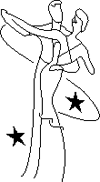 |
ROUND DANCING — CHOREOGRAPHED BALLROOMEDUCATIONAL ARTICLESMAJOR SECTIONS: Figures | Articles | Links | Alph. Index | Search | Home |
|
|
A Rosetta Stone For Ballroomby Roy & Phyllis Stier It used to be fashionable to purchase the Alex Moore BALLROOM DANCING to peruse it for valuable clues as to how round dancers should perform the burgeoning number of international figures. When comparing notes with other novices, it became increasingly evident that we were performing a blind-leading-the-blind exercise. Then our intrepid dance enthusiasts discovered the REVISED TECHNIQUE books (or Guy Howard's BALLROOM DANCING), which had an index and organizational format missing in the hard cover copy, particularly the presentation of the chart system. It is to this end that we would like to direct some remarks that could be helpful. The first thing that the reader/studier discovered is that the book figures are at considerable variance with established round dance standards. As soon as this came to light, the next step was to find that ballroom folks quite often give the beginning of the next figure as part of the description, and that corners are all important to them. For instance, the "feather & 3," which is an old standard, makes some sense when we see that the ballroom people use the Feather Step as a slow L fwd for the ending, then the 3-step as R, L, R, -; this last step leading into a natural turning figure. We get hopelessly bogged down if we take these in unit form and not in the neat package so characteristic of round dancing.Having sorted this out, we can then get some valuable information from the charts. Many people now realize that contra body movement (CBM) is a body turn to start a right-face or left-face movement — we like to think of this as "shaping." Contra body movement position (CBMP) is a foot position where one is in line with the other. As a consequence, our upper body is turned toward the partner to keep the shoulders parallel and we create the contra body position. So-called "keen" dancers well pay particular attention to the rise and fall, together with the sway. Too quick a rise in waltz will leave the dancer with nowhere to go on step 3. The early rise in fox trot and quickstep serve an important purpose if we don't allow this to inhibit the smoothness of movement in fox trot or the lightness that is characteristic of the quickstep. An easy rule to follow is to sway in the direction of the turn and straighten up at the end, together with no sway in rotary actions such as the spins and pivots. Beyond this, the reader/studier will get a little confused without some formal training. We translate promenade into semi-closed position (SCP) (counter promenade = reverse semi-closed position), zig zag into vine, outside partner into banjo (rarely do they go into our sidecar), and corte into a figure that has a slight dip. When going to reverse on the diagonals, they use "against line of dance." While we normally describe where we are facing, they use "backing" a great deal to clarify that the movement is in that direction or is about to be. In the charts, alignment refers to the foot and the body may lag behind, which is noted under amount of turn. So much more but …
This column comes from a series published in Cue Sheet Magazine between 1987 and 1992, and is reprinted with permission. The full series is collected in an 86-pg booklet, available for $30.00 plus postage. E-mail Fran Kropf at cutecuer@cox.net.
|
 |
|
|
Page last revised